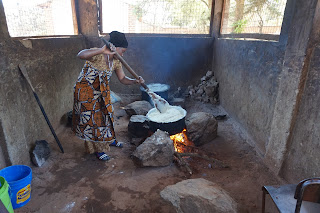A new problem for the Stove Team TECHNICAL POST

When the Marian Stove was designed not all of the local cooking needs were understood. As we traveled around the number one complaint about the Marian Stove was the inabality to hold the pot tightly while cooking Ugali. Ugali is a porridge type food made from flour, usually Maize. It is the staple food for all people in this area. On the smaller Marian Stoves, used in the villages for families this is less of a problem; the women there have fashioned simple pot holders that they can use to hold the pot firmly while they stir the Ugali. However, on the large institutional stoves, where Ugali is routinely prepared for hundreds of people at each meal ( for example Kaengasa Seminary, Katumba Secondary, the School for the Blind, etc..) things are a bit different. At these locations the Ugali is so thick, and the pots so deep, the women actually use a large oar to stir it. It takes considerable effort to keep the Ugali moving and you need high heat to...

